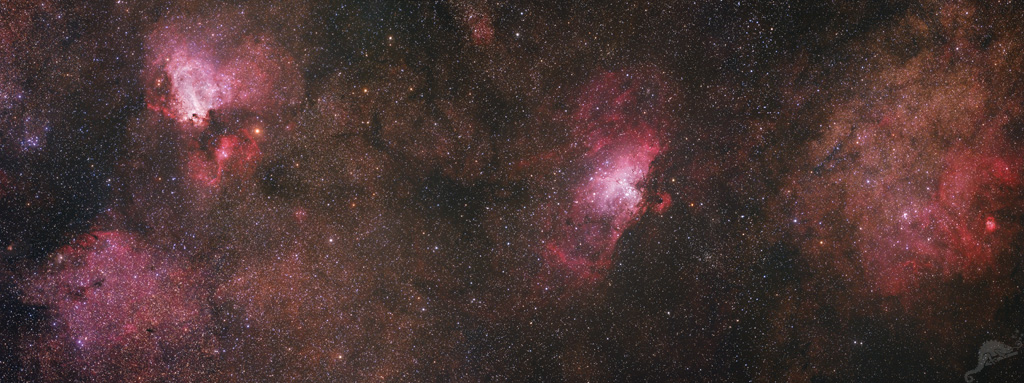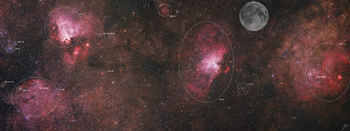 |
CHAMÄLEON + ONJALA OBSERVATORY DeepSky | SITEMAP HOME CHAMÄLEON |
|
 |
|||
| « back to overview nebulae | Großes Bild laden (3200 x 1400 Pixel 6100 x 2300 Pixel ) | Object description |

Our mosaic, composed of 5 single images with a total exposure time of nearly 8.5 hours, shows roughly the area from Messier 17, the Omega Nebula, through Messier 16, the Eagle Nebula, to the emission region Sharpless 2-54 (LBN 70/72), covering an area of about 1.5 x 6 degrees.
The image shows impressively how much hydrogen gas is present out there in our galaxy, enough material for star formation over billions of years to come. Besides the large emission nebula regions Messier 17 and IC 4703 (Messier 16 is actually the catalog name for the open star cluster within the H-II region), the mosaic shows two other extended H-II regions, Sharpless 2-54 (LBN 70/72) and IC 4601, and additionally 4 other open star clusters: Messier 18, NGC 6590, NGC 6604, and Trumpler 32.
Messier 18 (NGC 6613) is a small open star cluster, quite young at about 30 million years, in the constellation Sagittarius (Sagittarius). According to Trumpler it is assigned to class II 3 p n. The numerous bright blue giant stars are so hot that they shine mostly in blue light and near ultraviolet light. The stars are embedded in a reflection nebula region. M 18 is about 4600 light years from the Sun and was discovered by Charles Messier on June 3, 1764.
NGC 6596 - also an open star cluster - is much older than M 18. According to Trumpler it is assigned to class III 2 m n. The distance to the solar system is about 3600 light-years. The cluster was discovered by Friedrich Wilhelm Herschel on June 27, 1786.
The open star cluster NGC 6604 in the constellation Serpens is embedded in the H-II region Sharpless 2-54 (LBN 70/72). According to Trumpler it is assigned to class I 3 p n, the distance to the solar system is about 5500 light-years. The young cluster is a dense region of the so called Serpens OB stellar association, which contains about 100 stars of spectral classes O and B, among them the blue supergiant HD 167971. NGC 6604 was discovered on July 15, 1784 by Friedrich Wilhelm Herschel.
 |
A
detailed illustrated description by ESO .
can
be found here. From Messier 16 and Messier 17 we show high resolution images with detailed object descriptions here and here. « Click here or the thumbnail to load a large annoted image and a size comparison to the full moon. |
 |
 |
 |
 |
 |
 |
 |
| Sun | Moon | Solar System | DeepSky | Widefield | Miscellaneous | Spec. Projects |